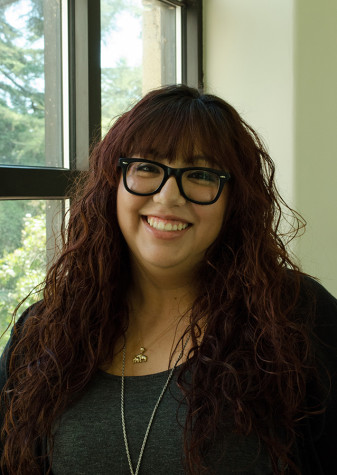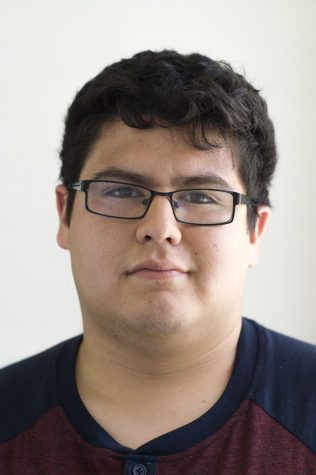Sign Language Interpreters: Gatekeepers of Communication
Jacquelyn Rubalcaba, deaf and hard of hearing counselor for Disabled Students Program & Services [DSP&S], describes her job as “gatekeepers of communication for our deaf and hard of hearing students.”
Before she became a counselor, Rubalcaba served as a sign language interpreter for the State Center Community College District both at Reedley College and Fresno City College from 2011 to 2013.
She said that at Reedley, she worked with three students, but that at FCC, the assignments were random. “Usually, you have from three to four deaf students. If one student was absent, we had to go in and reassign to other assignments. We were working with all the deaf students here on campus.”
Pushing Through the Limits.
Rubalcaba recalls her first encounter with deaf individuals from the ASL classes she took while a student. She fell in love with sign language, and it is that love that motivated her into the path of becoming a sign language interpreter.
To ready herself to help her students, Rubalcaba said she always wanted as much as she could get on the class or subject. The more an interpreter knows about the subject, the easier it is for them to interpret back to the student. She said that it is important that teachers give access to books and assignments.
“Interpreters have a well-rounded knowledge about a lot of things,” she said. “You always want to try to know as much, and being that we’re interpreters for all students; all students are interested in different things; multiple subjects.”
Rubalcaba describes her training in California State University, Fresno’s interpreting program as “daunting” yet “humbling”. She said the program was very professional in teaching students the ethics they should know, including hard training as well.
“Coming from a background in my native language, English, I excelled in academics,” Rubalcaba said. “Going into a language where I didn’t necessarily know, I had to work hard to prove myself.”
Roles and Responsibilities.
Rubalcaba said that the two major components of interpreting include sign to voice and voice to sign.
“When a deaf student is signing, I have to then interpret and use my voice so that hearing people or individuals in the classroom could understand the deaf person,” she said about sign to voice.
Conversely, when instructors are speaking, she must voice to sign so the hearing impaired students can understand.
“Your mind is always just going,” she said about being an interpreter. Rubalcaba said a lot of brain activity occurs and being an interpreter means you’re constantly thinking with no room for downtime.
Most interpreters have difficulty with lecture classes. Rubalcaba described interpreting lectures as “exhausting” because a lot of work is put into it.
“If you go into something not knowing the appropriate words to use, in this case, the appropriate signs,” she said, “interpreting becomes a lot more difficult.”
Challenges Faced.
Deaf and hard of hearing students face huge challenges in communication. Rubalcaba said she understands feeling out of place. While she’s very comfortable in arenas where people converse in English or sign language, she feels lost and very challenged when it comes to understanding languages like Spanish, for example.
“I interact with a lot of people who know Spanish. When I go to events and everyone’s speaking Spanish, I’m left out,” she explained, “When you feel left out, you don’t feel comfortable. A lot of times, that’s what deaf students are facing here on campus.”
She says a challenge for her as an interpreter is voicing. “I don’t consider myself an eloquent speaker, that’s something that I have always struggled with.”
Another challenge she faced was scheduling conflicts. “My schedule was constantly changing, so that means you never know what your set hours are going to be. So that’s probably what interpreters are facing.”
Rubalcaba says it takes a lot to interpret at a community college and that interpreters are breaking signs down into concepts as best as they can.
“When you come into an academic setting, there’s a lot of specialized vocabulary, a lot of jargon,” she said. “There’s not a specific sign; there’s a lot finger-spelling,” which takes up a lot of time.
In an academic setting, interpreters want to get the content out as best as possible, and signing at the same time can pose a challenge.
Relationship Between Interpreters and Students.
Overall, Rubalcaba describes being an interpreter as a cool thing.
“As an interpreter, you know that you’re providing a skill that others are intrigued by,” she said. “But, what’s more important is that you’re providing it to a deaf student who essentially needs you as part of their education.”
Most of all, she says, there’s a beautiful relationship between students and interpreters. It is a “formulated” relationship, she says; she wants to see the students succeed.
A student of hers, one of the first students she worked with, graduated recently from Reedley College. “I was able to go back and attend his ceremony, and congratulate him,” she said. “He was like, ‘It wouldn’t have been possible without you,’ and that makes you feel good.”


